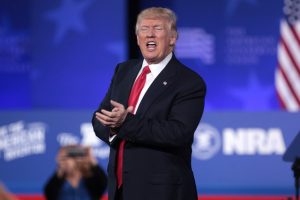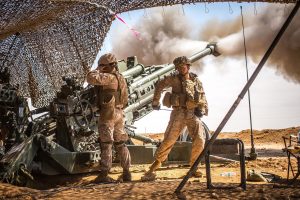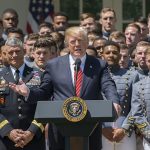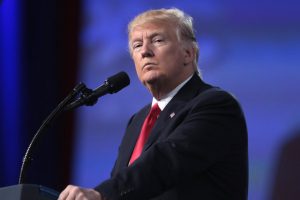by Catherine Killough
President Trump has consistently misrepresented the negotiation record between North Korea and the United States. In his speech before the South Korean National Assembly, he derived one conclusion from a complex history of hard-earned diplomatic achievements: “The North Korean regime has pursued its nuclear and ballistic missile programs in defiance of every assurance, agreement and commitment it has made to the United States and its allies.”
It is neither new nor uncommon to berate North Korea for its imperfect negotiating record, but it has never been more dangerous. In a series of tweets last month, Trump not only discredited past diplomatic efforts for “making fools of U.S. negotiators,” but also concluded with alarming ambiguity, “Sorry, only one thing will work!”
If not diplomacy, then that “one thing” sounds like a military strike, a serious proposal that has been reverberating throughout Washington’s foreign policy establishment. As Evan Osnos noted in his article for the New Yorker, “Is the Political Class Drifting Toward War with North Korea?” the idea of a preventive war has become so pervasive that even a former Democratic Cabinet secretary confided, “if he were in the government today he would support attacking North Korea, in order to prevent it from launching a strike on America.”
For those seeking to prevent a war that could result in millions of casualties on the Korean Peninsula, there are no military options. But for many Democrats, promoting diplomacy runs the risk of signaling weakness. Unsurprisingly, economic measures that straddle the line between being punitive and not-quite-war receive the widest bipartisan support.
Given this political environment, correcting the distorted history on US-North Korea negotiations is imperative—especially as the tendency to view talks as appeasement, or deals as concessions, grows stronger. Much of that stems from the way critics have framed the first US-led bilateral agreement with North Korea and its eventual collapse.
The Deal that Froze North Korea’s Nukes
In 1994, the United States and North Korea were at the brink of war. It was the first time that the relatively unknown regime north of the 38th parallel threatened to go nuclear. After expelling all international inspectors from the country, North Korea prepared to extract six bombs’ worth of weapons-grade plutonium from the fuel rods in its Yongbyon research reactor.
At the time, a fresh-faced President Bill Clinton considered taking military action, including a plan to conduct surgical strikes on North Korea’s nuclear facilities. Many of his top officials doubted that they could persuade the North Koreans from developing nuclear weapons. As Assistant Secretary of Defense for International Security Ashton Carter said, “We were not, by any means, confident that we could talk them out of taking that step.”
However, as former Secretary of Defense William Perry recalled, the risks of precipitating a second Korean War compelled the administration to pursue a diplomatic path. A meeting between former President Jimmy Carter and North Korean leader Kim Il Sung led to serious bilateral talks that culminated with the US-North Korea Agreed Framework on October 21, 1994.
In this landmark deal, North Korea agreed to freeze and eventually dismantle its graphite-moderated reactors in exchange for fuel and two proliferation-resistant light-water reactors. These reactors could produce power, but could not, practically speaking, be used to make nuclear weapons.
For nearly a decade, the United States sustained a direct, open line of communication with a paranoid and insecure regime. That level of engagement made it possible for two adversaries to commit to an agreement with a significant, material outcome: North Korea stopped producing plutonium for eight years. As former US Ambassador to South Korea Thomas Hubbard concluded, the Agreed Framework “proved to be imperfect… But it did prevent North Korea from producing as many as 100 nuclear weapons by now.”
Unfortunately, these achievements are overshadowed by the Agreed Framework’s collapse, wherein “collapse” has become synonymous with “failure.” But to say the deal failed too narrowly defines what success could realistically entail with a country carrying as much historical baggage as North Korea. Poor media coverage, including omissions of shortcomings on the US side of the deal, is partly to blame. But hawkish conservatives, who have long exploited the agreement as a cautionary tale of liberal appeasement, are largely at fault.
Both the United States and North Korea played a part in the Agreed Framework’s collapse, but the assertion that North Korea cheated obscures that fact. Soon after the Clinton administration brokered the deal, Republicans gained control of Congress, resulting in “a lack of political will,” according to chief negotiator Robert Gallucci, and led to significant delays in the delivery of US obligations.
Congressional opposition peaked again in 1998 amid accusations that the North was hiding an underground nuclear facility at Kumchang-ri. Instead of taking a punitive approach, the Clinton administration communicated its concerns directly to the North Koreans and, seeking to salvage the agreement, negotiated a new deal that permitted the United States regular inspections of the suspected site, where it failed to find any evidence of nuclear activity.
This diplomatic approach persisted even as North Korea’s advancing missile program sounded new alarms. Following North Korea’s launch of a long-range ballistic missile over Japan in 1998, the Clinton administration tasked a small team of inside and outside government experts with a North Korea Policy Review that would encompass the goals outlined in the Agreed Framework.
Former Secretary of Defense William Perry collaborated with the governments of North Korea, South Korea, China, and Japan in what became known as the Perry Process. Several rounds of negotiations culminated in 1999 with a report that outlined recommendations for the United States to pursue a verifiable suspension and eventual dismantlement of the North’s nuclear and long-range missile activities. In turn, the policy review team found that the United States must take steps to address the North’s security concerns and establish normal relations.
North Korea responded positively by not only agreeing to freeze its missile testing for the duration of talks, but also sending its senior military advisor to Washington to discuss the details of Perry’s proposal with President Clinton. Secretary of State Madeleine Albright reciprocated the visit by traveling to Pyongyang for a meeting with Kim Jong Il later that month.
However, momentum for what former Special Advisor to the President Wendy Sherman called a “tantalizingly close” proposal stalled the next month with the election of George W. Bush. Then-Secretary of State Colin Powell stated that North Korea policy would continue where Clinton left off, but Bush, who decided to cancel all negotiations with North Korea for the next two years, overruled him.
The Bush administration veered far off the diplomatic course that the Clinton administration took pains to maintain. Bush added North Korea to his triad of “axis of evil” states. Dick Cheney rejected diplomacy for regime change, asserting, “We don’t negotiate with evil. We defeat it.” Then-Undersecretary of State for Arms Control John Bolton used intelligence reports about a suspected secret uranium enrichment program to kill a deal he never favored. In his own words, “This was the hammer I had been looking for to shatter the Agreed Framework.”
In the end, the Bush administration alleged that a North Korean official confirmed the existence of the suspected uranium enrichment program. North Korea denied the admission, which led to back-and-forth accusations that each side was in violation of the deal. Instead of working to overcome mounting distrust, the United States backed out of the deal in 2002.
The Agreed Framework Redux
Bush’s refusal to engage with North Korea came back to haunt his administration in 2003. North Korea quickly resumed its plutonium program and announced it possessed a nuclear weapon. Convinced of the need to re-enter negotiations, the United States joined China, Russia, Japan, and South Korea in the Six Party Talks.
Several rounds of dialogue led to a breakthrough two years later with the 2005 Joint Statement, which pledged the North to abandon “all nuclear weapons and existing nuclear programs.” But no sooner had the six parties announced the agreement than the US Treasury froze North Korean assets in the Macau bank, Banco Delta Asia.
For the North Korean leadership, choking off their access to $25 million in capital was a grave offense and suggested that the United States was not serious about making a deal. Even those working for the administration, such as chief negotiator Ambassador Christopher Hill, saw the act as an attempt “to sidetrack the negotiations entirely.”
Whatever the US Treasury’s intentions, the freeze had the effect of unraveling years of hard-earned progress to rebuild trust. North Korea retaliated in 2006 by not only test-firing eight missiles, but also detonating its first nuclear device.
The United States just barely salvaged negotiations by lifting the freeze and removing North Korea from the State Sponsors of Terrorism list in 2007. In return, North Korea readmitted nuclear inspectors and disabled its Yongbyon reactor, exploding the cooling tower in a dramatic televised event. But enough damage had been done that by the time new disputes arose over verification measures, the Six Party Talks landed at a stalemate and failed to move into the final phase of dismantling North Korea’s nuclear weapons program.
The Limitations of Strategic Patience
Like the administration before him, President Obama was slow to broker negotiations with North Korea. Though Obama made clear from the onset that he would take a pro-diplomacy approach and “extend a hand” to those regimes “willing to unclench your fist,” North Korea fell low on his list of foreign policy priorities.
Instead, a policy of “strategic patience” stood in for any targeted effort to bring North Korea back to the negotiating table. Although the door for talks remained technically open, the United States pursued sanctions and pressure campaigns not unlike the Trump administration’s current posture. North Korea fired back its share of provocations, including a second nuclear test and two deadly skirmishes on its border with South Korea.
It was not until 2011 that the Obama administration restarted denuclearization talks. After a brief hiccup following the death of Kim Jong Il, the two countries announced a “Leap Day” deal in February 2012. North Korea agreed to a moratorium on its long-range missile and nuclear tests in exchange for 240,000 metric tons of food aid.
Sixteen days later, North Korea announced its plans to launch a satellite into space. The United States held to the view that such a launch would violate the terms of the agreement, while North Korea claimed, “the satellite launch is not included in the long-range missile launch” and proceeded with its plans.
The administration immediately scrapped the deal, a perplexing move given past US efforts to address the risks of dual-use missile technologies. For example, for decades the United States denied South Korean requests to extend the range of their ballistic missiles out of fear that it would start a regional arms race. Amid growing pressure, the United States reached an agreement in 2001 that broadened the scope of South Korea’s missile activities while including specific constraints on its space launch program, such as the expressed use of liquid fuel.
Instead of revisiting the deal to more clearly distinguish what is acceptable in terms of a satellite or missile launch, the United States let negotiations with North Korea, once again, fall to the wayside.
The Only Option
If Bush had kept the Agreed Framework, if hardliners had not sabotaged the Six Party Talks, and if Obama had clarified the terms of the Leap Day deal, North Korea might not be the nuclear nightmare that grips the United States and its allies today.
But broken promises and burned bridges are no excuse for abandoning diplomacy. There are plenty of lessons within the cracks of an uneven negotiation record that are worth extracting, including the need to address North Korea’s security concerns head-on and the critical importance of US interagency coordination.
There is still an opening for compromise with North Korea, but Trump threatens to close it every time he underestimates the value of negotiations. As every president since Clinton has eventually come to understand, if the alternative with North Korea is war, every diplomatic option has to be explored to its fullest. Millions of lives hang in the balance.
Catherine Killough is the Roger L. Hale Fellow at Ploughshares Fund, a global security foundation. She earned her MA in Asian Studies from the School of Foreign Service at Georgetown University. Follow on Twitter @catkillough. Photo: Jimmy Carter and Kim Il Sung.






It’s a shame that such an important essay should be so poorly written, concealing its true significance in the middle of the piece. The writer seems to be saying that North Korea’s bellicosity is more because diplomacy collapsed than because it has failed. Why she didn’t say that in the first paragraph dismays me.
US policy is that selective appointed US enemies should not be allowed to employ nuclear deterrence which has been a cornerstone of US security, with three delivery methods, for decades. So millions of people must die because of this American Exceptionalism, with provocative massive US military forces (including puppet ROK forces) on DPRK’s doorstep in a war which the US refuses to end.
The premise of this article, that negotiations with North Korea “work” is belied by the obvious fact that its criminal regime now possess the nuclear weapons and the means of delivering them that all of the negotiations the author’s detail were undertaken to prevent. Alleged mistakes on the American side do not change this fact. The North Koreans always knew what it is we and our allies objected to and what we sought to prevent them doing. Does it occur to the authors that “give-us-aid-and-ignore-our-criminality-throughout-the-world-or-we-will-develop-illegal-weapons-of-mass-destruction” is a position of blackmail, not a pretext for good-faith negotiations? The very premise of negotiating with the DPRK over its WMD and missile development programs was flawed from the start. While the authors seem inclined to offer Kim the Sudetenland, what this article unintentionally documents is three decades of good-faith, intensive efforts on the American side consistently frustrated by a perfidious adversary.
Moreover, what about the Kim regimes’ repeated violations of each of these agreements? These are glossed over throughout the article, with all hypothetical “ifs” and counter-factual laments aimed at impugning the U.S. For instance, the authors ignore Pyongyang’s willful violation of the “Leap Day” deal (as though it doesn’t take a long-range missile to launch a satellite), and minimize the DPRK’s instigation of “two deadly skirmishes on its border with South Korea,” (the sinking of the Cheonan and the shelling of Yeonpyeong) each of which was an act of war in their own right. If clearer heads had prevailed we would have fought the inevitable war necessary to eliminate the Kim regime then, before it acquired nuclear weapons.
“The only option” left to the U.S. and its allies (which is also to say the U.N.) is to eliminate the existential threat Pyongyang’s missile and WMD programs present to the region and the world. What is most lamentable is that we have a risible buffoon (and probable Russian-mole) in the White House and a myopic (and likely compromised) ex-CEO running the State Department, neither of whom knows anything about diplomacy and each of whom hold it in contempt.
The sad fact is: there is nothing left to negotiate. Events of the last year make clear that there will not “be peace in our time” until the Kim regime is annihilated, the people of North Korea are freed from its oppression, and the threats it poses to us and our allies are eliminated. The government of the U.S. is not responsible for this unfortunate reality. More pusillanimous nincompoopery (aka: negotiations) will only placate an overtly hostile, nuclear armed regime whose “leader” has explicitly threatened to attack our nation—as well as our allies—with the very nuclear weapons we have spent three decades negotiating to prevent him acquiring.
The premise of this article, that negotiations with North Korea “work” is belied by the obvious fact that its criminal regime now possess the nuclear weapons and the means of delivering them that all of the negotiations the authors detail were undertaken to prevent. Alleged mistakes on the American side do not change this fact. The North Koreans always knew what it is we and our allies objected to and what we sought to prevent them doing. Does it occur to the authors that “give-us-aid-and-ignore-our-criminality-throughout-the-world-or-we-will-develop-illegal-weapons-of-mass-destruction” is a position of blackmail, not a pretext for good-faith negotiations? The very premise of negotiating with the DPRK over its WMD and missile development programs was flawed from the start. While the authors seem inclined to offer Kim the Sudetenland, what this article unintentionally documents is three decades of good-faith, intensive efforts on the American side consistently frustrated by a perfidious adversary.
Moreover, what about the Kim regimes’ repeated violations of each of these agreements? These are glossed over throughout the article, with all hypothetical “ifs” and counter-factual laments aimed at impugning the U.S. For instance, the authors ignore Pyongyang’s willful violation of the “Leap Day” deal (as though it doesn’t take a long-range missile to launch a satellite), and minimize the DPRK’s instigation of “two deadly skirmishes on its border with South Korea,” (the sinking of the Cheonan and the shelling of Yeonpyeong) each of which was an act of war in their own right. If clearer heads had prevailed we would have fought the inevitable war necessary to eliminate the Kim regime then, before it acquired nuclear weapons.
“The only option” left to the U.S. and its allies (which is also to say the U.N.) is to eliminate the existential threat Pyongyang’s missile and WMD programs present to the region and the world. What is most lamentable is that we have a risible buffoon (and probable Russian-mole) in the White House and a myopic (and likely compromised) ex-CEO running the State Department, neither of whom knows anything about diplomacy and each of whom hold it in contempt.
The sad fact is: there is nothing left to negotiate. Events of the last year make clear that there will not “be peace in our time” until the Kim regime is annihilated, the people of North Korea are freed from its oppression, and the threats it poses to us and our allies are eliminated. The government of the U.S. is not responsible for this unfortunate reality. More pusillanimous nincompoopery (aka: negotiations) will only placate an overtly hostile, nuclear armed regime whose “leader” has explicitly threatened to attack our nation—as well as our allies—with the very nuclear weapons we have spent three decades negotiating to prevent him acquiring.
Please eliminate the typo “author’s” and replace with “authors” in the first sentence of the comment I have submitted. Thank you very much!